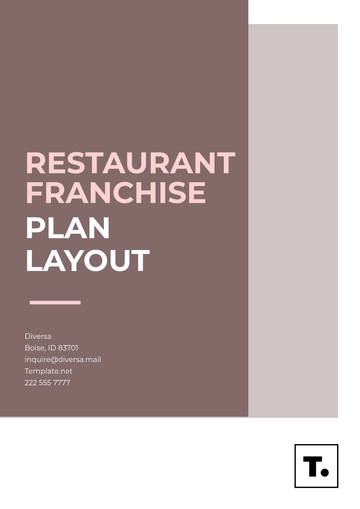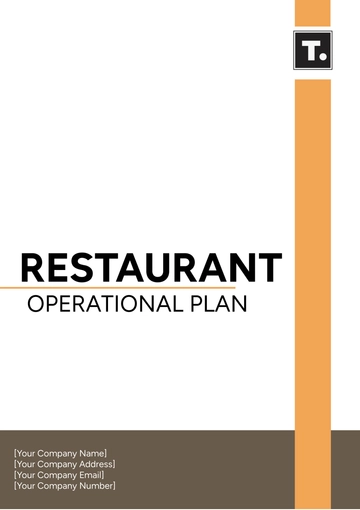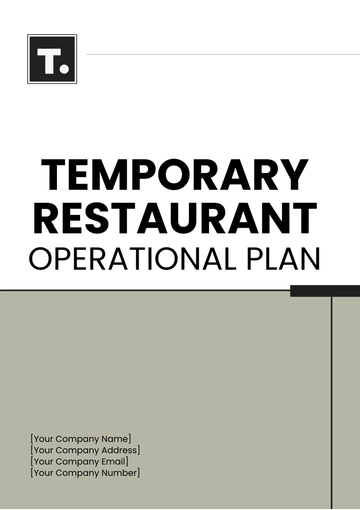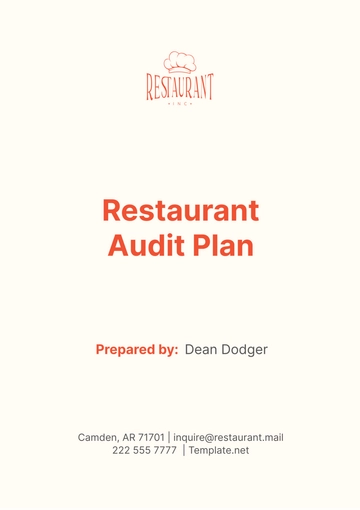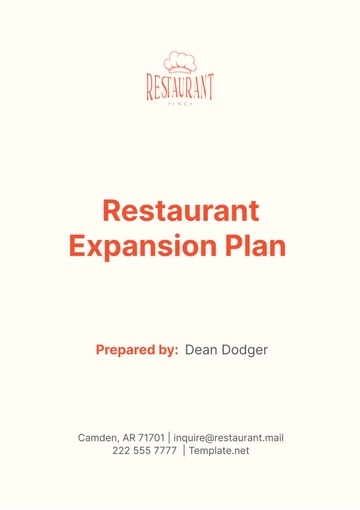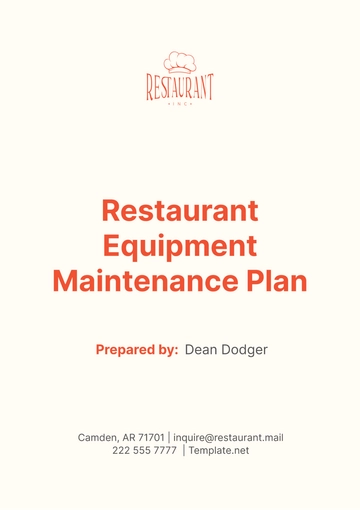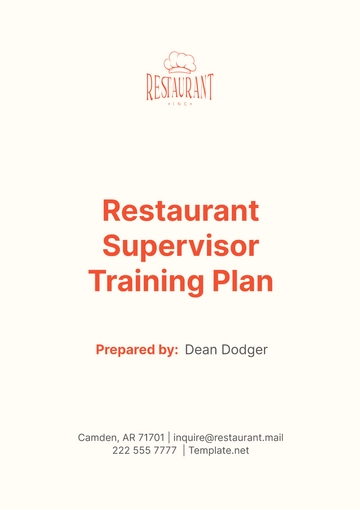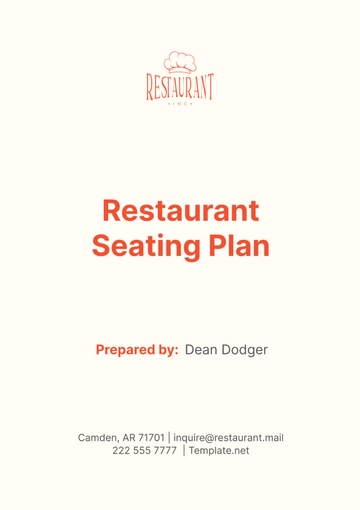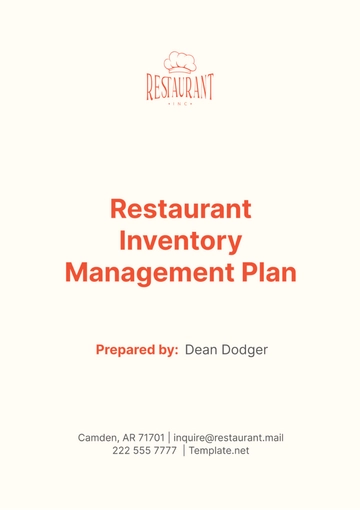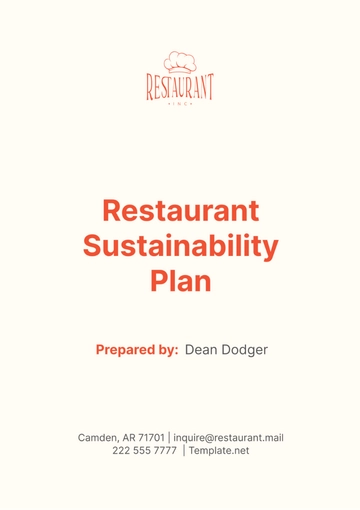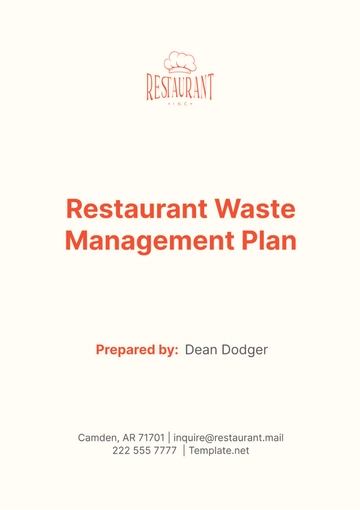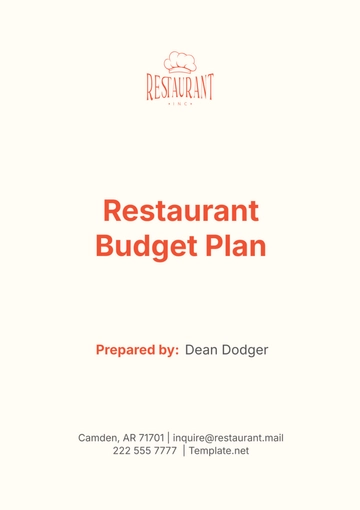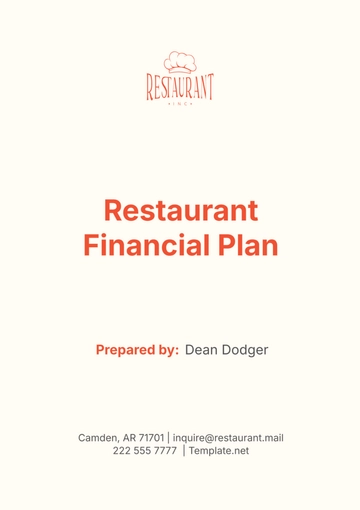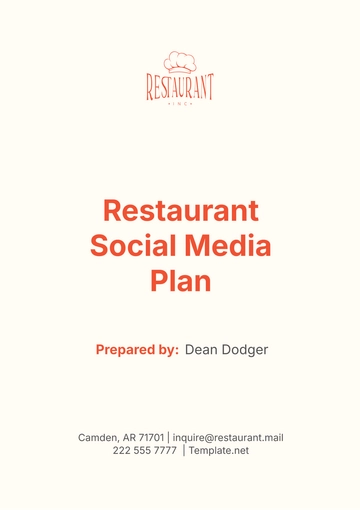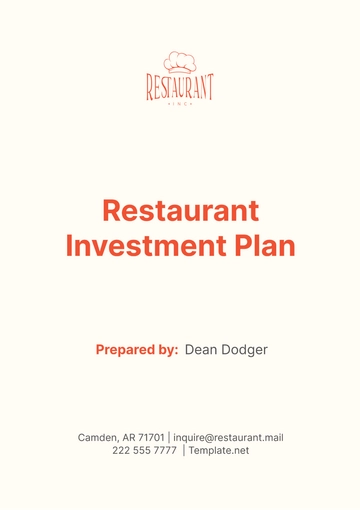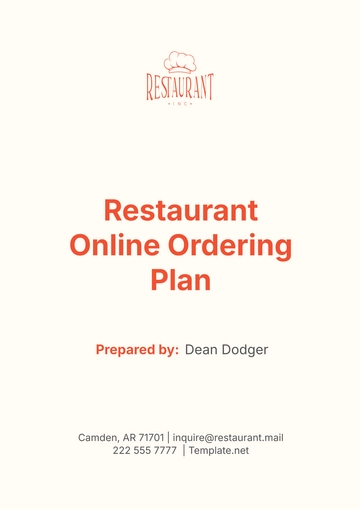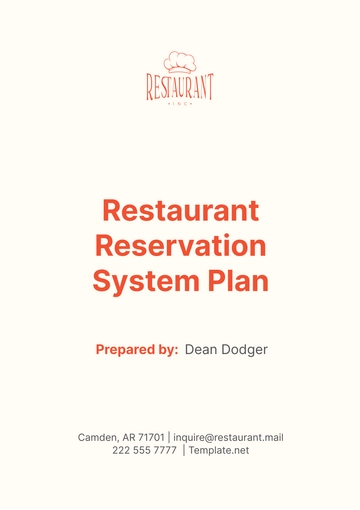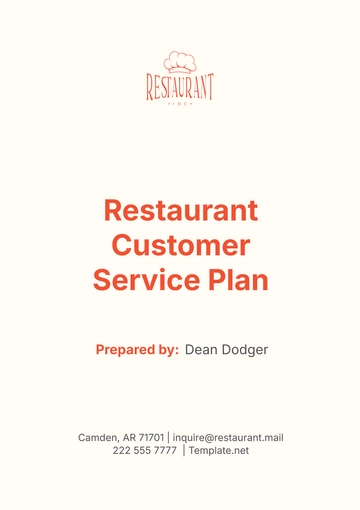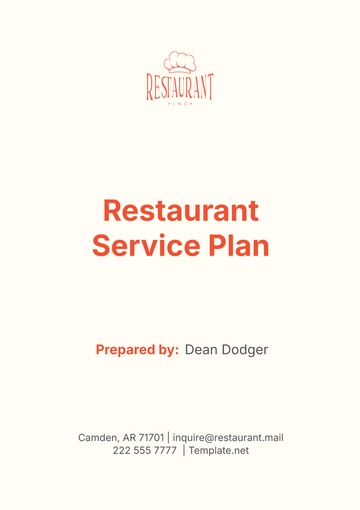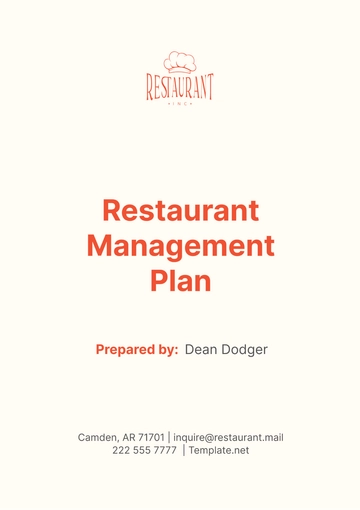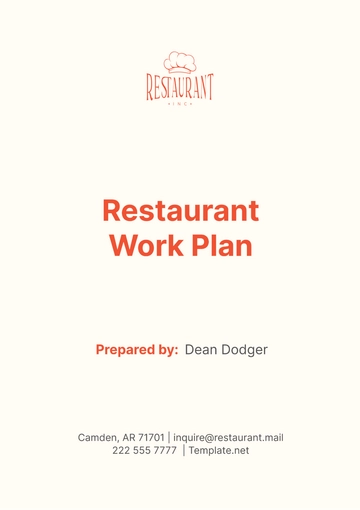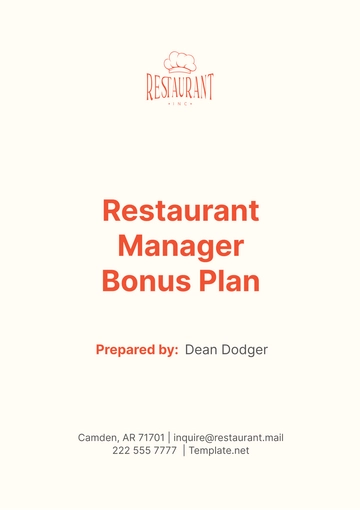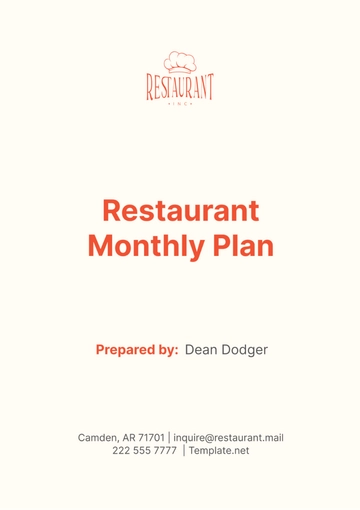Free Restaurant Management Plan

I. Introduction
Our restaurant is a vibrant establishment dedicated to providing exceptional dining experiences to our guests. As we continue to grow and evolve, it's essential for us to establish clear guidelines and procedures to ensure the smooth operation of our business. This Restaurant Management Plan serves as a comprehensive framework outlining our operational and managerial strategies, guiding our team towards success while maintaining our commitment to excellence in every aspect of our operations.
II. Organization Structure
In order to maintain efficiency and accountability within our restaurant, we have established a clear organizational structure with defined roles and responsibilities for each team member. Our structure is designed to facilitate effective communication, streamline decision-making processes, and optimize workflow. The following table outlines the key positions within our organization:
Position | Responsibilities |
|---|---|
General Manager | Overall management of daily operations |
Head Chef | Menu development, kitchen operations |
Front of House Manager | Guest relations, staff supervision |
Sous Chef | Assists head chef in kitchen operations |
Restaurant Supervisor | Floor management, customer service |
Head Server | Ensures smooth service, trains new servers |
Line Cooks | Prepares and cooks food according to recipes |
Servers | Takes orders, serves food and beverages |
Host/Hostess | Greets guests, manages reservations |
III. Staffing Plan
Ensuring that we have the right team in place is crucial to the success of our restaurant. Our staffing plan takes into account the various roles and positions required to operate efficiently and provide excellent service to our guests. The following table outlines our staffing requirements:
Position | Number Required |
|---|---|
Head Chef | 1 |
Sous Chef | 2 |
Line Cooks | 4 |
Servers | 8 |
Host/Hostess | 2 |
Front of House Manager | 1 |
Restaurant Supervisor | 1 |
Once we have identified our staffing needs, we will begin the recruitment process by posting job openings on online job boards, social media platforms, and local job fairs. We will also leverage our professional networks and employee referrals to attract qualified candidates. Each candidate will undergo a thorough interview process, including a review of their qualifications, experience, and fit with our company culture. Successful candidates will then undergo onboarding and training to ensure they are equipped with the necessary skills and knowledge to excel in their roles.
IV. Operations Plan
A. Operating Hours
Our restaurant will operate according to the following hours:
Monday to Thursday: 11:00 AM to 10:00 PM
Friday and Saturday: 11:00 AM to 11:00 PM
Sunday: 11:00 AM to 9:00 PM
B. Health and Safety Protocols
The health and safety of our guests and staff are of paramount importance to us. To ensure a safe dining environment, we have implemented the following protocols:
Regular sanitization of high-touch surfaces.
Use of personal protective equipment (PPE) for staff.
Adherence to local health department guidelines regarding food handling.
Implementation of social distancing measures.
Daily health screenings for staff members.
C. Quality Control Measures
Maintaining consistency and quality in our offerings is essential to meeting and exceeding customer expectations. To achieve this, we have established the following quality control measures:
Regular tasting sessions to ensure menu items meet our standards.
Ongoing training for kitchen staff to uphold cooking standards.
Monitoring guest feedback and addressing any issues promptly.
Regular inspections of ingredients and supplies to ensure quality.
Performance evaluations for staff members to identify areas for improvement and recognition of excellence.
V. Menu Management
A. Menu Development
Our menu development process involves a collaborative effort between our head chef, sous chefs, and management team. We prioritize creativity, seasonality, and customer preferences when crafting new dishes and updating our menu offerings.
B. Ingredient Sourcing
We are committed to sourcing the freshest and highest quality ingredients for our dishes. Our sourcing strategy emphasizes partnerships with local farmers, fishermen, and suppliers who share our values of sustainability and ethical practices.
C. Pricing Strategy
Our pricing strategy is designed to balance affordability with profitability. We conduct regular market research to ensure our prices are competitive while still reflecting the quality and value of our offerings. The following table illustrates our pricing strategy:
Item | Our Price | Competitor Price |
|---|---|---|
Appetizer | ||
Entree | ||
Dessert |
VI. Marketing Promotion
Our marketing and promotion efforts are aimed at increasing awareness, attracting new customers, and fostering loyalty. Key strategies include:
Social Media Marketing: Engaging with our audience on platforms like Instagram, Facebook, and Twitter to showcase our menu items, promotions, and events.
Email Marketing: Sending targeted email campaigns to subscribers with special offers, discounts, and updates about our restaurant.
Influencer Partnerships: Collaborating with local influencers and food bloggers to reach new audiences and generate buzz.
Community Events: Hosting or participating in community events, fundraisers, and local festivals to connect with our community and build relationships.
Loyalty Program: Implementing a loyalty program to reward frequent customers and encourage repeat visits.
Online Reviews and Reputation Management: Monitoring online reviews and actively managing our online reputation to ensure positive feedback and address any concerns promptly.
VII. Financial Management
A. Budgeting
Budgeting is a crucial aspect of our financial management process, allowing us to allocate resources effectively and ensure financial stability. We develop annual budgets that outline projected revenues and expenses across various categories. The following table provides an overview of our budget for the upcoming year:
Category | Budgeted Amount ($) |
|---|---|
Food and Beverage | |
Labor | |
Marketing and Advertising | |
Utilities | |
Rent and Leases | |
Maintenance | |
Contingency | |
Total |
B. Forecasting
Financial forecasting allows us to anticipate future financial performance and make informed decisions to achieve our goals. We utilize historical data, market trends, and industry insights to develop accurate forecasts. The following table illustrates our revenue forecast for the next three years:
Year | Projected Revenue ($) |
|---|---|
Year 1 | |
Year 2 | |
Year 3 |
C. Cost Control Measures
Cost control is essential for maintaining profitability and financial health. We implement various measures to monitor and manage costs effectively, including:
Regular review of expenses and identification of areas for cost savings.
Negotiation with vendors to secure favorable pricing and terms.
Implementation of inventory management systems to minimize waste and optimize purchasing.
VIII. Vendor Management
Effective vendor management is crucial for ensuring quality, reliability, and cost-effectiveness in our supply chain. We establish strong relationships with our vendors based on mutual trust and communication. Our vendor management process includes:
Conducting thorough vetting and due diligence before selecting vendors.
Negotiating contracts and agreements that outline terms, pricing, and expectations.
Regular communication and feedback to address any concerns promptly.
Performance evaluation to ensure vendors meet our standards.
Exploring opportunities for strategic partnerships and collaboration to drive mutual growth and success.
IX. Risk Management
In any business, there are inherent risks that may impact operations and financial performance. It's essential for us to identify, assess, and mitigate these risks to minimize their potential impact. The following table outlines key risks, their likelihood, and potential impact:
Risk | Likelihood | Impact |
|---|---|---|
Health and Safety | High | High |
Food Safety | Medium | High |
Economic Downturn | Medium | Medium |
Staff Turnover | Medium | Medium |
Competition | High | Medium |
To address these risks, we have developed the following mitigation strategies:
Health and Safety: Implementing strict health and safety protocols, including regular sanitation, staff training, and compliance with local regulations.
Food Safety: Adhering to stringent food safety standards, regular inspections, and proper handling procedures.
Economic Downturn: Diversifying revenue streams, maintaining a contingency fund, and closely monitoring economic indicators.
Staff Turnover: Offering competitive wages, providing opportunities for advancement, and investing in staff training and development.
Competition: Continuously monitoring market trends, adapting our offerings to meet changing customer preferences, and focusing on delivering exceptional value and service.
X. Continuous Improvement
Continuous improvement is essential for staying competitive and achieving long-term success. We are committed to ongoing evaluation and refinement of our operations to drive excellence and innovation. The following table outlines key performance metrics and target values:
Metric | Target Value |
|---|---|
Customer Satisfaction | 90% or above |
Food Cost Percentage | 25% or below |
Staff Retention Rate | 85% or above |
Average Table Turnover Time | 45 minutes or less |
Evaluations will occur on a quarterly basis, with department heads and management reviewing performance against targets. Any deviations or areas for improvement will be identified, and action plans will be developed and implemented accordingly. Additionally, we encourage feedback from both staff and customers to identify opportunities for enhancement and innovation.
- 100% Customizable, free editor
- Access 1 Million+ Templates, photo’s & graphics
- Download or share as a template
- Click and replace photos, graphics, text, backgrounds
- Resize, crop, AI write & more
- Access advanced editor
Discover the Restaurant Management Plan Template by Template.net. This versatile template provides an editable and customizable framework for managing restaurant operations effectively. With sections for organization structure, staffing plan, and quality control measures, it's ideal for restaurant owners and managers. Take control of your restaurant's success and streamline operations with this comprehensive template, editable in our AI Editor tool.
You may also like
- Finance Plan
- Construction Plan
- Sales Plan
- Development Plan
- Career Plan
- Budget Plan
- HR Plan
- Education Plan
- Transition Plan
- Work Plan
- Training Plan
- Communication Plan
- Operation Plan
- Health And Safety Plan
- Strategy Plan
- Professional Development Plan
- Advertising Plan
- Risk Management Plan
- Restaurant Plan
- School Plan
- Nursing Home Patient Care Plan
- Nursing Care Plan
- Plan Event
- Startup Plan
- Social Media Plan
- Staffing Plan
- Annual Plan
- Content Plan
- Payment Plan
- Implementation Plan
- Hotel Plan
- Workout Plan
- Accounting Plan
- Campaign Plan
- Essay Plan
- 30 60 90 Day Plan
- Research Plan
- Recruitment Plan
- 90 Day Plan
- Quarterly Plan
- Emergency Plan
- 5 Year Plan
- Gym Plan
- Personal Plan
- IT and Software Plan
- Treatment Plan
- Real Estate Plan
- Law Firm Plan
- Healthcare Plan
- Improvement Plan
- Media Plan
- 5 Year Business Plan
- Learning Plan
- Marketing Campaign Plan
- Travel Agency Plan
- Cleaning Services Plan
- Interior Design Plan
- Performance Plan
- PR Plan
- Birth Plan
- Life Plan
- SEO Plan
- Disaster Recovery Plan
- Continuity Plan
- Launch Plan
- Legal Plan
- Behavior Plan
- Performance Improvement Plan
- Salon Plan
- Security Plan
- Security Management Plan
- Employee Development Plan
- Quality Plan
- Service Improvement Plan
- Growth Plan
- Incident Response Plan
- Basketball Plan
- Emergency Action Plan
- Product Launch Plan
- Spa Plan
- Employee Training Plan
- Data Analysis Plan
- Employee Action Plan
- Territory Plan
- Audit Plan
- Classroom Plan
- Activity Plan
- Parenting Plan
- Care Plan
- Project Execution Plan
- Exercise Plan
- Internship Plan
- Software Development Plan
- Continuous Improvement Plan
- Leave Plan
- 90 Day Sales Plan
- Advertising Agency Plan
- Employee Transition Plan
- Smart Action Plan
- Workplace Safety Plan
- Behavior Change Plan
- Contingency Plan
- Continuity of Operations Plan
- Health Plan
- Quality Control Plan
- Self Plan
- Sports Development Plan
- Change Management Plan
- Ecommerce Plan
- Personal Financial Plan
- Process Improvement Plan
- 30-60-90 Day Sales Plan
- Crisis Management Plan
- Engagement Plan
- Execution Plan
- Pandemic Plan
- Quality Assurance Plan
- Service Continuity Plan
- Agile Project Plan
- Fundraising Plan
- Job Transition Plan
- Asset Maintenance Plan
- Maintenance Plan
- Software Test Plan
- Staff Training and Development Plan
- 3 Year Plan
- Brand Activation Plan
- Release Plan
- Resource Plan
- Risk Mitigation Plan
- Teacher Plan
- 30 60 90 Day Plan for New Manager
- Food Safety Plan
- Food Truck Plan
- Hiring Plan
- Quality Management Plan
- Wellness Plan
- Behavior Intervention Plan
- Bonus Plan
- Investment Plan
- Maternity Leave Plan
- Pandemic Response Plan
- Succession Planning
- Coaching Plan
- Configuration Management Plan
- Remote Work Plan
- Self Care Plan
- Teaching Plan
- 100-Day Plan
- HACCP Plan
- Student Plan
- Sustainability Plan
- 30 60 90 Day Plan for Interview
- Access Plan
- Site Specific Safety Plan
